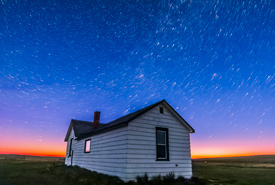Paradise for daytrippers and stargazers

Star trails over Butala Homestead in OMB at dawn, SK (Photo by Alan Dyer)
Imagine plains so vast and wide that the night sky is flooded with stars and the Milky Way as far as the eye can see. There is one Nature Conservancy of Canada (NCC) property renowned for its rolling grasslands and nightscape: Old Man on His Back Prairie and Heritage Conservation Area (OMB) in southwest Saskatchewan.
OMB's openness wows visitors upon arrival and leave a feeling humbleness on return — that they’re a part a grander landscape on the 13,088-acre (5,297-hectare) ranch land. OMB was designated nocturnal preserve status by the Royal Astronomical Society of Canada (RASC) in 2015; the first of its kind on an NCC property. This year also marks the 20th anniversary for this grassland jewel.

Panorama showing OMB's visitor centre (Photo by Alan Dyer)
So what is it really like out on OMB? Let’s hear it from the people who’ve experienced its wonders first-hand.
Dale Gross, NCC’s natural areas manager of Missouri Coteau shares why OMB is a destination for all:
"I’ve been lucky enough to spend time at OMB the last three years. It’s a special place for me and I’ve brought my family out for certain occasions; we all love it! You really notice the quiet and it can get very still around dusk as the stars come out.
"And the storms are fantastic. There is very little to obscure the skies in southern Saskatchewan, especially at OMB. So you can watch clouds change shape and colour and observe rain showers as they move across the landscape. Lightning and thunder explode in the sky better than any fireworks display I’ve ever seen. It is a real pleasure for the senses to be part of that.
"We’ve got to know the neighbours too. Some really wonderful people out there. They come and help us with the bison round up every year. It is truly incredible to be right next to a plains bison. I highly recommend Old Man on His Back as a must-see destination in Saskatchewan."

Panorama of OMB's beautiful nightscape (Photo by Alan Dyer)
Chris Beckett, past national observing chair and past president of the RASC Regina Centre also recounts his visit to OMB:
"The first time I drove into OMB it was a clear, hot, 40-degree-Celsius, dusty afternoon. My wife and I approached the plateau by driving up successively higher hills with rounded tops. As we neared the site we could clearly see the snow-capped peaks in Montana to the south.
"I never thought I'd see mountains from Saskatchewan, so that was a magical experience. Being out under the dark sky with unobstructed horizons in all directions is like walking into a real life planetarium. Typically one strains their eyes to see the Milky Way, but from OMB it rises up on summer evenings directly out of the south as a huge trail of billowing clouds; like those from a locomotive arching up overhead, then disappearing over the north eastern horizon.
"The significance of the OMB Nocturnal Preserve is another step towards securing dark skies for all animals; from migrating songbirds who fly at night, to humans who need total darkness for restorative sleep.
"Such preserves are meaningful, as light pollution encroaches on all areas; making such dark pristine places very rare sites. NCC's involvement is another avenue for educating the wider public [about the importance of] reducing light usage at night. Since the OMB location needed almost no modifications to meet guidelines it was a perfect fit for the Nocturnal Preserve Program. This is truly a conservation message people can take home with them and use to help reduce their own light pollution footprint."
Alan Dyer, astronomy author and photographer says OMB is an ideal spot for stargazing:
"Photographing the night sky at OMB is an astrophotographer's dream. The sky is as dark as you'll find it in Canada, and the wide-open prairie allows you to see the entire sky from horizon to horizon with nothing to get in the way! I love it!"
Get a sneak peak of OMB’s magnificence, below. Photography and video by Alan Dyer.
Night on a Pioneer Homestead from Alan Dyer on Vimeo.


